Picture Book Round-Up ‘Round the World
 May 28th, 2008 by jules
May 28th, 2008 by jules
Come. Take a trip in my airship…around the world a bit for a look at some picture books from across the pond. Let’s get right to it . . .
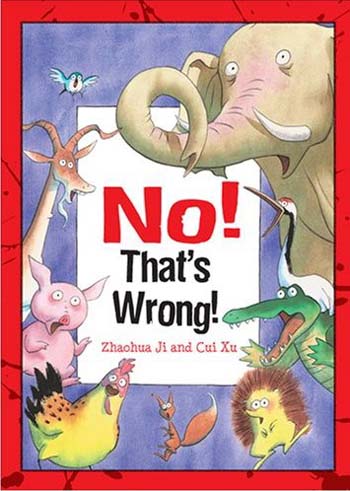
by Zhaohua Ji and
Cui Xu
Kane/Miller
March 2008
Move over, Pigeon.
Here’s an interactive picture book from Chinese illustrating duo Zhaohua Ji and Cui Xu. Collectively, they’ve apparently won awards for their illustration, cartoons, and fiction in China as well as in Japan and Europe, yet this is their first picture book. And in it they ask such philosophical questions as: When is a hat not a hat? And when are underpants not underpants?
In the opening spread, we see a pair of red underpants (red? Ooh la la. No ordinary skivvies for those people) fly off a clothesline, landing in the next spread on a rabbit’s head. What’s this? he wonders. It’s a hat!
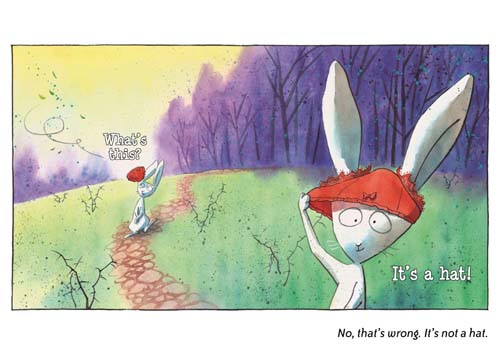
The rabbit runs into all his animal friends who try the underpants on and each declare in happy superlatives what a great hat it is, indeed. All this is captured on colorful spreads (we’re talkin’ vivid blues, deep purples, and resonant reds), corralled by one thin black-lined border around all the action, under which is text in the surrounding white space assumed to be supplied by the reader: “No, that’s wrong. It’s not a hat.” This you can see pictured above. When the rabbit meets a know-it-all donkey who tells him he’s wearing underpants on his head, the rabbit denies it, though the bottom text tells him, “Yes, that’s right. They’re underpants.” Finally, the rabbit tries them on the proper way, thus launching one rollicking metafictional argument between the characters and the reader. “No, that’s wrong” his friends tell him as he wears them on his bum. “Don’t listen! They’re underpants!” the bottom text, supplied by the reader, tells him. Taking matters into his own hands, the rabbit finally picks up the thin black border surrounding his world, and pulls it up, thus eliminating the reader’s words and declaring “It’s a wonderful hat!” — as well as freeing up the watercolors, as they slide down into what was formerly white space:
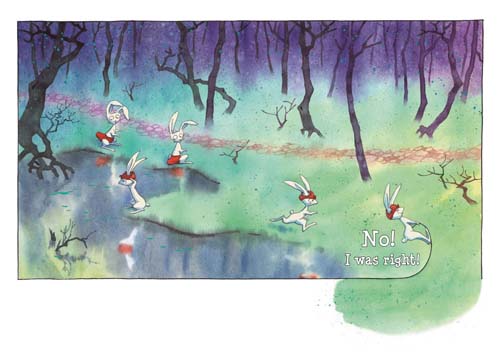
The endpapers show his animal friends wearing various items of clothing on their heads (or antlers, as it may be). Needless to say, this is one very giggle-inducing story for young children (what with the underpants as well as the very fun characters), but it’s more than that (or, as Betsy Bird put it in her review, “Geez oh petes, there’s all kinds of stuff going on in this book”): There’s the interactive, break-the-fourth-wall text, which will have young listeners and readers yelling right back at the book; the stubborn determination on the part of the rabbit, something to which young readers/listeners can relate; and the tight-knit community of animal friends, all standing behind the rabbit’s decision to accept the underpants as a hat, no matter the sense it fails to make. An engaging book. Beautiful watercolors. Fun with yelling at the picture book protagonist. Don’t miss it.

by Yoshitomo Nara
Chronicle Books
March 2008
(Originally published in Japan in 1999)
This is one strange, compelling picture book by Yoshitomo Nara, one of Japan’s most popular contemporary Pop artists — his first book for children, in fact. The dramatic action is simple: A dog, too big for anyone to even notice him, is finally noticed by a young girl, who befriends him. She sings songs for him. He takes her home. There ya have it, my friends. But there’s a lot I like here. First, young readers will be drawn to the notion that a dog is so huge, he can’t even be seen or noticed by anyone, thus leaving him terribly lonely. (I’m tellin ya’ — he spans continents. He’s that huge.) “I was always hoping for someone, somewhere, to be my friend,” he says in the opening, something to which children can certainly relate. There’s also the seriously bizarre little girl, looking angry half the time, not so much someone you’d want befriending you. But she’s determined, making the long climb up the dog’s tall leg and being surprised to find it’s a canine. When her serious face lights up with a smile, it’s a hoot, especially since we’re surrounded in this world by so many saccharine-sweet picture books. Nara’s images are bordered with thick, black lines, and there are occasional bold colors put to use here — the bright yellow, for one, stands out. He makes effective use of close-ups and plays with perspectives quite a bit, making this one you want to pore over for a while. If I have one complaint, it’s that Nara suddenly switches to second-person point-of-view at the end, speaking directly to the reader, giving us a message we don’t necessarily need to have pointed out to us: “No matter how alone you are, there is always someone, somewhere, waiting to meet you. Just look and you will find them!” But I almost don’t even mind, since right after that he gives us four wonderfully bizarre, wordless spreads of them playing together, even showing us what he had already told us on the aforementioned suddenly-instructive page: “Though sometimes they fought, as friends do, they still had fun and played together.” This is a definite 2008 WAPD candidate. But I loves me some weird. Some refreshingly weird. Take a look, and come back and tell me what you think.

by Chris McKimmie
Allen & Unwin
June 2008
(First published in 2007)
This isn’t the picture book you want when you’re looking for a traditional narrative structure, but this is what you want for a Maira-Kalman-esque, Max-like romp through a child’s fantasy world by Australian Chris McKimmie. And this picture book is a fine example of how a picture book author can nail a child’s voice (“Six sleeps to Christmas”), but I’m getting ahead of myself . . . Maisie Moo lives in the Gone Bonkers Discount Palace with her mother and her father, but he’s not home. He drives a truck and is mostly absent. Her best friend is Invisible Lucy, and her dog is Drongo, “lazy as a pillow. His favourite letter is ZZZzzzzzzz…” Maisie likes Drongo, Lucy, sleeping in, and playing the drums. She does not like being called an angel, as her dad often calls her, and she most certainly does not like playing the angel in the Venice Christmas concert. “I would rather play the drums or be the donkey. ‘Not the bum bit,’ says Invisible Lucy.” Yes, Maisie’s just a bit tired of the adults in her life defining who she is, as much as she loves them: “Goodnight, little angel,” they say, and on one striking spread I wish I could show you here, she says one more time, “I DON’T WANT TO BE AN ANGEL,” McKimmie having painted her with a devil mask on her face. Powerful stuff. In what passes as the book’s climax, Maisie—frustrated with her father’s absence, it’s safe to say, and frustrated with, well . . . not really being heard by the adults in her life—kicks a box of gondolas at the store, blaming it on Invisible Lucy. The next morning, having vented her anger, she’s feeling a bit better, and her dad’s home. Best of all, “{a}t the Venice Christmas concert, I wasn’t the angel. I wasn’t the donkey. But I got to play ‘Silent Night’ on my drums. ‘Love it,’ said Invisible Lucy. It was all a little bit wonderful.” . . . McKimmie writes with flair (“The earth was as red as toffee apples and the clouds as pink as fairy floss…”), and he goes far in this title with relating to children who feel their voices aren’t being heard, who need a moment of empowering. Does everyone want to be seen as angelic, perfectly holy all the time? Nah. Do kids need to be mischievous and have us acknowledge it? You betcha. The art here is a free-form, Chagall-esque, kaleidoscopic mixed-media delight. The eye-popping spread of Maisie’s father telling her bed-time stories best epitomizes what Kirkus Reviews described as McKimmie’s “{v}igorous brushwork.” The humor is cheeky and the energy infectious. An Australian import worth checking out.

by Catarina Kruusval
Translated by
Joan Sandin
R & S Books
April 2008
(Originally published in Sweden in 2007 as
Fia och djuren)
Swedish author/illustrator Catarina Kruusval brings us in Franny’s Friends a simple story of camaraderie and the imaginative play of children, perfect for the wee’est of children. “Franny has seven friends: Croakie Crow, Barry Bear, Honey Bunny, Ginger Giraffe, Dashie Doggy, Little Heddy Hedgehog, and Itty Bitty Kitty. Franny plays with her friends every day.” That right there absolutely grabs the youngest of listeners — hook, line, and sinker. Stuffed-animal friends. With detailed names. Yet not too imaginative. (We’ve talked about this before — most children’s books will have the young protagonists give their toys the most wildly imaginative names, when in reality, they do things like name their new tiny toy pony, “Gray Body White Head Pony,” as my daughter just did. “Little Heddy Hedgehog”? Yup, Kruusval got it just right.) Franny takes her toys on an outing one sunny morning. With a pleasing repetition (Kruusval names each animal repeatedly, showing readers in what order they’re lined up) which makes your wee listener’s face light up, they have their lovely picnic (with details that continue lighting up faces) and then race and play. Little Heddy and Itty Bitty Kitty stumble and fall into a hole. There’s much drama here, Itty Bitty Kitty lying in the hole, crying. “But no one hears Little Heddy or Itty Bitty Kitty.” The others keep running and playing, not even noticing two friends are gone (expect gasps here) — not until later. Of course, once they notice their absence, they go on an all-out hunt for them, eventually rescuing them. On the way home, Franny, who had insisted on being first in line, now falls behind at the back of the line, perhaps having learned to keep her eye on her more vulnerable friends. With Kruusval casting Franny in the role of caretaker (which lots of children, especially girls, like to pretend-play), children will delight in this simple story of friends-on-an-outing. Just try to read this once to a child; I’d bet money you get asked to read it multiple times. It’s a winner.
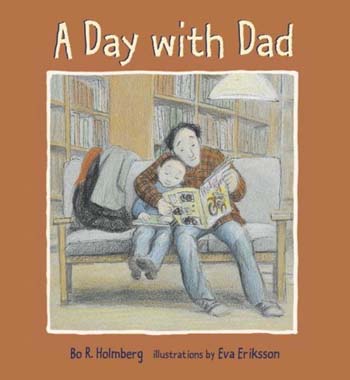
by Bo R. Holmberg
Illustrated by
Eva Eriksson
Candlewick
April 2008
This book from Swedish duo Holmberg and Eriksson can be described in one word: touching. Yes, “touching” gets over-used in book-reviewing, to be sure, but for serious, my friends…the text and the illustrations are so tenderly-rendered and the subject matter so sensitive that it both wows me and makes me tear up, blast it all, every time I read it. A young boy, Tim, has just moved to a new town with his mother. His father lives in another town. Never once is the word “divorce” or “separation” used, but it doesn’t need to be, as it’s evident that Tim’s parents are estranged. Meeting his dad at the train station to spend a whole day together, Tim is thrilled. They don’t do anything spectacular together — on the surface, that is. It’s clear that, to both Tim and his father, doing things like buying hot dogs on Main Street, seeing a movie together, having a pizza dinner afterwards, and merely sitting together in the library reading together (as pictured on the cover) is spectacular enough for them:
Tim and Dad sit together in the library. Dad flicks through a magazine while Tim holds a book. He’s going to check it out. Time doesn’t know what time it is. He doesn’t want to know. He doesn’t want Dad’s train to leave soon.
Using just about every opportunity he gets to point out “this is my dad” with tremendous pride to everyone they encounter that evening, Tim is glued to his father’s side. Finally, his dad has to catch his train. “As they walk to the station, Dad holds Tim’s hand. Dad’s hand is big, and Tim’s small hand disappears inside it.” (Cue first round of tears.) And then when Tim’s dad decides to show him the inside of the train, he suddenly makes an announcement to all inside: “Well . . . this is Tim. He is my son. He is the best son anyone could have.” (Cue second rounds of tears.) After Tim’s mom shows up and they watch the train take off, his dad waving through the window, “Dad’s hand gets smaller and smaller.” Tim and his mom watch the train disappear, and the final illustration—of the two of them from behind—is a wonder, Eriksson conveying so much with the body language of her characters, the mother practically slumping over her son as he rests his sad head against her body. It’s really beautiful stuff, and Holmberg knows exactly the kind of details to which children attend, filling the narrative with it, making the story come to vivid life. Eriksson’s colored pencil illustrations are elegant, appropriately subdued, and warm. There aren’t many books about divorce. Take Nancy Coffelt’s and Tricia Tusa’s Fred Stays With Me! from last year (reviewed here) for one with some serious spunk. Take Holmberg’s and Eriksonn’s for some tenderness — and an attempt at some healing.

by Elena O’Callaghan
Illustrated by
Àfrica Fanlo
Kane/Miller
March 2008
(Original Edition: 2006;
Catalan title:
S’han tornat bojos!)
When I first read this book, I was baffled for a majority of the spreads, as the reader is supposed to be. When I got to the final punchline spread, my laugh could probably be heard a few states away. And if you’ve ever been a new parent, experiencing the boot camp of early parenthood, you will likely get a kick out of it, too. This book also completely works as the perfect choice for children expecting a new sibling. No heavy-handed lessons on how life will change needed here. This book spells it out with great humor and a bit of mystery, some guess-work needed on the part of the reader.
A young boy lays out—on each spread—how his life was before (before what? That’s for you to figure out) and then how it is now. In the opening spread, on the left (“before”), we see him practicing his violin in his calm, clean, organized world. On the right side of the spread (the “now”), he has drawn on the walls, is eating junk food, is watching television, and is generally making a mess. His mother? She used to sit and read. Now? She’s got enough laundry to last her a lifetime. His dad? He’s mastered the art of multi-tasking:
And so it goes. “In the last three months, strange things have been happening around here . . . really strange things.” His parents can’t stay awake for long anymore; his father brushes his teeth with hair gel; his mother sprays her hair with bug spray and puts salt—instead of sugar—on his strawberries; and, worst of all, his bedtime stories are shorter now. Can you guess what’s going on? Well, “the only one who’s not acting strange is my baby sister,” he tells us on the final spread. “She’s really cute. Yesterday, she turned three months old.” Yup, I want to give this to every new parent I know — to give them a much-needed laugh. But, humor aside, I really think this is a good choice for that sibling with a new, screaming wee one in the home. It will open up all kinds of doors for discussion about how family life is altered by his/her arrival. Fanlo’s illustrations (created digitally, it seems, but don’t quote me on that) are exaggerated and play up the inherent humor in the text. (Fanlo lives in Barcelona, incidentally, if you’re wondering which country we’re visiting now, and I believe Elena is also from Spain, but don’t quote me on that either.) A clever, fun, wink-wink title about the lovely chaos a baby can bring to a family.
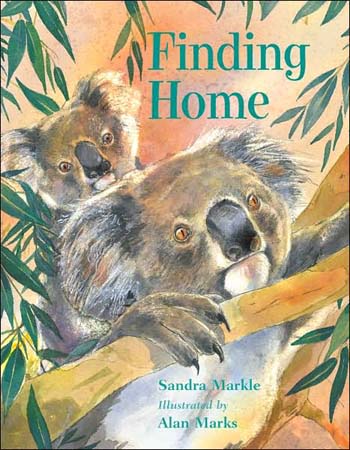
by Sandra Markle
Illustrated by
Alan Marks
Charlesbridge
February 2008
This is a story, based on the real-life account of a koala nicknamed Cinders, of a mother koala and her joey, the mother trying to save her baby from a bushfire. It comes from Sandra Markle, who lives in New Zealand, and Alan Marks, who lives in the UK. Fire sweeps through the forest in September, and a koala and her baby cling to life on a tree. Luckily, they’re unharmed, but “only shadow-black skeletons remain where koalas once dined on a daily buffet of different kinds of eucalyptus trees…” Leaving the forest to search for a meal with her joey on her back, the mother finally sniffs some food but has ended up in a residential area; a dog even spots her. When a human girl notices the koala and takes the dog in, the mother and baby climb a tree, later noticing that a crowd has gathered to watch her. Since it’s a koala’s habit to move around for meals, she does so and is followed by people with “bright beams of light that make her blink and her joey squeal.” For a couple more days, she moves from tree to tree, all the while people following her, “chattering, humming, buzzing…” After they allow her to cross a road safely, “one by one, the lights go out and the noises stop.” The people have directed her to the forest, and “she bounds up to the high, tender branches of a forest red gum.” . . . Markle seamlessly blends in facts about koalas in this dramatic tale. Marks’ watercolor, pen, and pencil illustrations are reverent and detailed — as well as dramatic when they need to be (the fire spread bursts with color). Take a moment to visit his site and see some of his art; there’s a real Brock Cole feel to some of it (while still being singularly Alan-Marks). A good choice for school libraries for units about conservation and wildlife, this is a survival story and a tale of the many ways creatures find—and define—home.
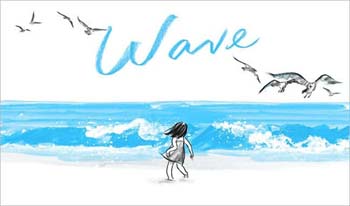
by Suzy Lee
Chronicle
April 2008
More on this book later, because I’ve asked picture book creator Suzy Lee, who is quickly becoming one of my Favorite Picture Book Creators Ever, for a seven-questions-over-breakfast interview. I can’t promise the interview, since—speaking of the lovely chaos of a new baby (as we did above with O’Callaghan’s and Fanlo’s book)—she has a new one herself and will do her best to answer as many questions as she can if she gets to it at all. But we can cross fingers, and I’ll tell you more about the wonderful wordless Wave then.
Thanks for taking a quick trip-’round-the-world with me. Until next time…
Top two spreads from NO! THAT’S WRONG! Copyright © 2008 Zhaohua Ji and Cui Xu. Reproduced by permission of the publisher, Kane/Miller. All rights reserved.
Last spread from WHAT’S GOING ON? Copyright © 2006 Elena O’Callaghan. Illustration copyright © 2006 Àfrica Fanlo. Reproduced by permission of the publisher, Kane/Miller. All rights reserved.

Wow, my head is spinning from all these goodies. Such a trip! Did you hear me squealing over the Franny’s Friends cover? And the Maisy Moo book — just breathe Chagall and Maira Kalman near me and I’m sold. And that first book, about the red underpants. I have the same problem!
Thanks so much, Jules. You totally rocked around the world and then some :).
Thanks, Jama! If you see any of ’em, let me know what you think.
Oh you’ve made my day! Four of these titles, Wave, A Day With Dad, Maisie Moo and Invisible Lucy, and the Lonesome Puppy (yes, it gets a nod for WAPB), are really really special. Thanks for the reviews. I will have to read the others. I look forward to that Suzy Lee Interview she’s a favorite too. We’ve read The Zoo many times over.
I read No! That’s Wrong! a couple weeks ago and wondered if it might be a good one for Jason and I to read together in our joint storytimes, but I’m not sure we could manage it without laughing a lot. I also think both of us would want to be the person reading the “No, that’s wrong” parts.
one of my favorite student essays ever involved chickens, sleepwalking, and underwear as hairpiece.
[…] in 2008, I covered another of McKimmie’s titles. If you want to read that here, you might get a good sense of what his art is like. (Let me tell you that about 99.9999998% of the […]
Thanks for celebrating NO THAT’S WRONG! It is one of my favorite picture books for the last few years. At the same time it is wild and funny, it also touches on issues of public expectations and personal interpretation.
I remember looking at the 2nd book at the library as a kid in its og language
I meant the no thats wrong book